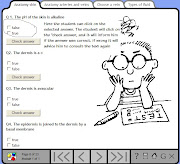I have managed to almost finish the written part of the first part of this assignment I have used storyboarding and PowerPoint in the design and development phase of the ADDIE model.
Based on this, I have created a clinical teaching e-learning event using the VTS interactive e-learning tool. I have read numerous suggestions on bloggs such as “The e-Learningcoach ( available at http://thelearningcoach.com), and have explored tools such as iSpring, Moodle and in a lot of detail, the VTS interactive e-learning tool. With some help I have created and used a blogg, discovered what RSS feeds mean and used “Google Reader” to keep me up-to-date with activities on bloggs I followed. In short I have learned so much in the past week, and may I say, I have barely scratched the surface of what is out there.
Once you enter the world of e-Learning it is an amazing journey. It is also a journey that never reaches a destination. What is new technology today is old news tomorrow. The never ending pool of new developments, new applications, and new search engines just keeps on spiraling. It will consume your life if you do not manage it. It will make you forget you have family and friends, and it will make you forget to live. The trick is, as with all things in life, to find a balance between what is out there and what is here and now.
As was discussed at the recent SAAHE conference, the concept of open source or open access to information is not out there in the future, it is very much here and now. Neil Burcher delivered a key note address on the topic of open education resource (OER) (available at : http://www.oerafrica.org). What struck me most of his presentation was his comment that if universities do not become involved in open access resources, they will find themselves at a disadvantage. Across the globe universities are exploring the possibilities of OER. In the UK a university called The Open Resource University (OU) is a university dedicated to distance learning. They have around 150,000 undergraduate and more than 30,000 postgraduate students. 10,000 of their students have disabilities. The Open University's style of teaching is called supported open learning.
Littlejohn et al (2006) in an article called “Characterizing effective eLearning resources” discusses the key characteristics of learning resources that have proved effective in changing learning and teaching. They have identified twelve key characteristics shown to be effective learning resources. These are:
Materials can be easily sourced
The resources are durable and maintained
The resources have a degree of quality assurance
The resources are free from legal restrictions
The resources are available at an appropriate cost
The resources are in formats that are accessible and ubiquitous within the community
The resources are in media that present intelligible representations in terms of language
The resources are easily repurposed
Resources should be sufficiently small to be reusable, but large enough to ensure that tutors do not have to spend time aggregating large numbers of resources
Resources should be presentable in a context that is meaningful for the user
Resources should engage the learner
Resources should be reusable in a range of educational models or learning designs
I am in favor of OER as it will allow educators across the globe to freely exchange learning material, and it will allow students to freely access and benefit from its use. Perhaps in Africa it is time that we start sharing our knowledge instead of keeping it guarded to benefit a privileged few.





